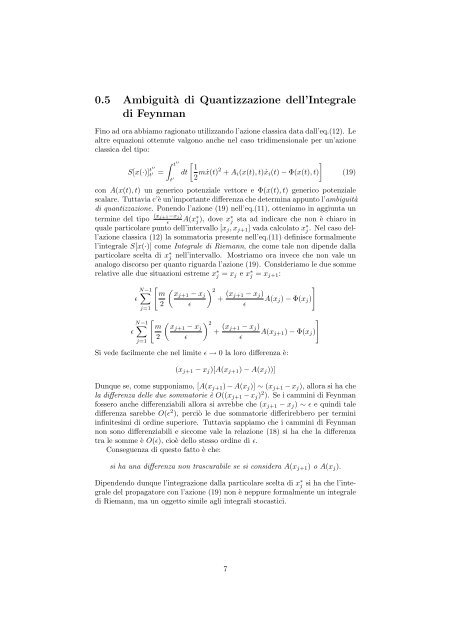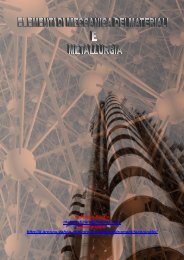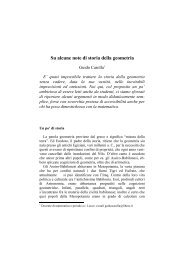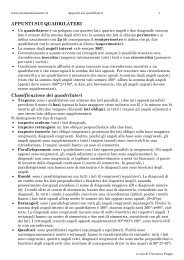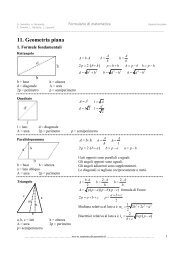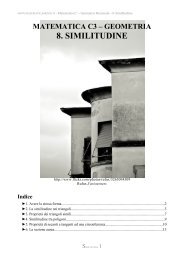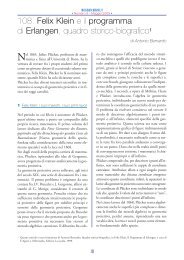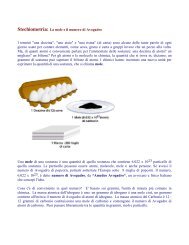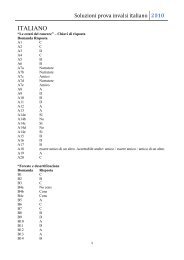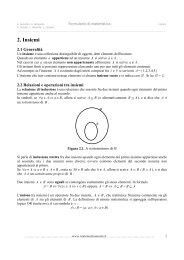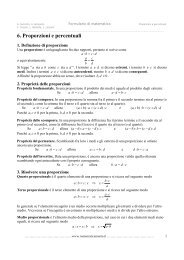Scarica la tesi Integrale di Feynman sui Cammini e Processi Stocastici
Scarica la tesi Integrale di Feynman sui Cammini e Processi Stocastici
Scarica la tesi Integrale di Feynman sui Cammini e Processi Stocastici
You also want an ePaper? Increase the reach of your titles
YUMPU automatically turns print PDFs into web optimized ePapers that Google loves.
0.5 Ambiguità <strong>di</strong> Quantizzazione dell’<strong>Integrale</strong><br />
<strong>di</strong> <strong>Feynman</strong><br />
Fino ad ora abbiamo ragionato utilizzando l’azione c<strong>la</strong>ssica data dall’eq.(12). Le<br />
altre equazioni ottenute valgono anche nel caso tri<strong>di</strong>mensionale per un’azione<br />
c<strong>la</strong>ssica del tipo:<br />
S[x(·)] t′′<br />
′′<br />
t<br />
t ′ =<br />
t ′<br />
<br />
1<br />
dt<br />
2 m ˙x(t)2 <br />
+ Ai(x(t), t) ˙xi(t) − Φ(x(t), t)<br />
(19)<br />
con A(x(t), t) un generico potenziale vettore e Φ(x(t), t) generico potenziale<br />
sca<strong>la</strong>re. Tuttavia c’è un’importante <strong>di</strong>fferenza che determina appunto l’ambiguità<br />
<strong>di</strong> quantizzazione. Ponendo l’azione (19) nell’eq.(11), otteniamo in aggiunta un<br />
termine del tipo (xj+1−xj)<br />
ɛ A(x∗ j ), dove x∗j sta ad in<strong>di</strong>care che non è chiaro in<br />
quale partico<strong>la</strong>re punto dell’intervallo [xj, xj+1] vada calco<strong>la</strong>to x∗ j . Nel caso dell’azione<br />
c<strong>la</strong>ssica (12) <strong>la</strong> sommatoria presente nell’eq.(11) definisce formalmente<br />
l’integrale S[x(·)] come <strong>Integrale</strong> <strong>di</strong> Riemann, che come tale non <strong>di</strong>pende dal<strong>la</strong><br />
partico<strong>la</strong>re scelta <strong>di</strong> x ∗ j<br />
nell’intervallo. Mostriamo ora invece che non vale un<br />
analogo <strong>di</strong>scorso per quanto riguarda l’azione (19). Consideriamo le due somme<br />
re<strong>la</strong>tive alle due situazioni estreme x∗ j = xj e x∗ j = xj+1:<br />
ɛ<br />
ɛ<br />
N−1 <br />
j=1<br />
N−1 <br />
j=1<br />
<br />
m<br />
2<br />
<br />
m<br />
2<br />
xj+1 − xj<br />
ɛ<br />
xj+1 − xj<br />
ɛ<br />
2<br />
2<br />
+ (xj+1<br />
<br />
− xj)<br />
A(xj) − Φ(xj)<br />
ɛ<br />
+ (xj+1<br />
<br />
− xj)<br />
A(xj+1) − Φ(xj)<br />
ɛ<br />
Si vede facilmente che nel limite ɛ → 0 <strong>la</strong> loro <strong>di</strong>fferenza è:<br />
(xj+1 − xj)[A(xj+1) − A(xj))]<br />
Dunque se, come supponiamo, [A(xj+1) − A(xj)] ∼ (xj+1 − xj), allora si ha che<br />
<strong>la</strong> <strong>di</strong>fferenza delle due sommatorie è O((xj+1 − xj) 2 ). Se i cammini <strong>di</strong> <strong>Feynman</strong><br />
fossero anche <strong>di</strong>fferenziabili allora si avrebbe che (xj+1 − xj) ∼ ɛ e quin<strong>di</strong> tale<br />
<strong>di</strong>fferenza sarebbe O(ɛ 2 ), perciò le due sommatorie <strong>di</strong>fferirebbero per termini<br />
infini<strong>tesi</strong>mi <strong>di</strong> or<strong>di</strong>ne superiore. Tuttavia sappiamo che i cammini <strong>di</strong> <strong>Feynman</strong><br />
non sono <strong>di</strong>fferenziabili e siccome vale <strong>la</strong> re<strong>la</strong>zione (18) si ha che <strong>la</strong> <strong>di</strong>fferenza<br />
tra le somme è O(ɛ), cioè dello stesso or<strong>di</strong>ne <strong>di</strong> ɛ.<br />
Conseguenza <strong>di</strong> questo fatto è che:<br />
si ha una <strong>di</strong>fferenza non trascurabile se si considera A(xj+1) o A(xj).<br />
Dipendendo dunque l’integrazione dal<strong>la</strong> partico<strong>la</strong>re scelta <strong>di</strong> x∗ j si ha che l’integrale<br />
del propagatore con l’azione (19) non è neppure formalmente un integrale<br />
<strong>di</strong> Riemann, ma un oggetto simile agli integrali stocastici.<br />
7


